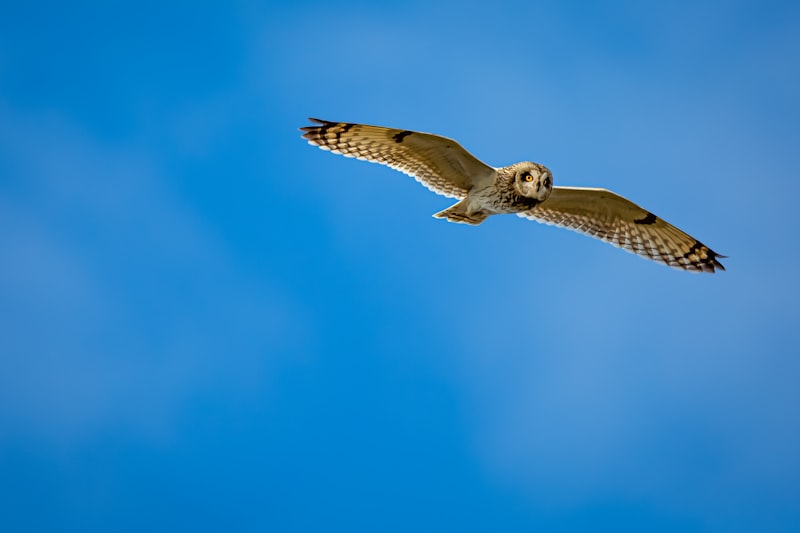Flying insects, like bees, flies, and butterflies, fascinate with their graceful maneuvers through the air. Have you ever wondered how these tiny creatures defy gravity with such ease? The biomechanics of flying insects reveal a marvel of evolution and engineering.
At the heart of their flight prowess lies their wings. Insects’ wings are not just delicate membranes but intricate structures designed for efficiency. Unlike birds or bats, insects don’t flap their wings up and down; instead, they generate lift by creating a whirlwind effect with each stroke. This rapid, figure-eight motion allows them to hover, dart, and pivot with incredible agility.
A key element in this biomechanical ballet is the exoskeleton. Insects’ bodies are encased in a lightweight yet sturdy exoskeleton that provides support and protection. This outer shell also anchors the muscles responsible for wing movement, ensuring each flap is precise and powerful.
Moreover, flying insects have mastered the art of aerodynamics. Their streamlined bodies minimize air resistance, enabling them to achieve remarkable speeds relative to their size. This efficiency is further enhanced by their ability to adjust wing shape and angle mid-flight, optimizing lift and maneuverability in real-time.
Consider the humble bumblebee. Its ability to defy aerodynamic principles by generating lift with small, rapid wing movements is a testament to nature’s ingenuity. By studying these biomechanics, scientists gain insights into flight mechanics that inspire innovations in robotics and aviation technology.
The biomechanics of flying insects exemplify nature’s elegance and efficiency. From their intricate wings to their streamlined bodies and precise muscle control, these tiny aviators embody a perfect fusion of biology and physics. Next time you see a dragonfly darting through the air or a butterfly fluttering from flower to flower, marvel at the biomechanical wonders that allow them to defy gravity with such grace and ease.
Unraveling the Secrets: How Flying Insects Master the Biomechanics of Flight
Flying insects, from delicate butterflies to resilient dragonflies, have evolved remarkable adaptations that enable them to conquer the skies. At the heart of their ability lies intricate biomechanics that scientists have been unraveling for decades. Unlike birds or bats, insects rely on a completely different flight mechanism that is as efficient as it is awe-inspiring.
One of the key secrets lies in their wings. Insects’ wings are not just mere extensions of their bodies; they are marvels of engineering. Made of thin membranes stretched over a network of veins, these wings are incredibly lightweight yet robust enough to endure the demands of flight. They beat their wings in a distinctive figure-eight pattern, generating lift and thrust with each stroke. This unique motion allows them to hover, maneuver swiftly, and even fly backwards—a feat that few other creatures can match.
But it’s not just about their wings. The muscles that power insect flight are equally remarkable. These muscles are finely tuned to contract and relax rapidly, driving the wings through thousands of beats per minute. Such rapid movement requires exceptional energy efficiency, and insects achieve this through a combination of muscle design and aerodynamic prowess.
Biomechanically speaking, flying insects are masters of efficiency. They have evolved to minimize energy expenditure while maximizing lift and maneuverability. Imagine a tiny bee effortlessly navigating through a garden of flowers, or a dragonfly darting with pinpoint precision to catch its prey—it’s a testament to millions of years of evolution fine-tuning their flight mechanics.
Insects also leverage aerodynamic principles to enhance their flight capabilities. Their streamlined bodies reduce drag, allowing them to maintain high speeds with minimal effort. Furthermore, some insects can adjust the angle and shape of their wings mid-flight, optimizing their aerodynamic performance based on changing conditions.
Wings of Wonder: Exploring the Biomechanics Behind Insect Flight
Have you ever marveled at the effortless grace with which insects navigate the air? The intricate dance of flight, from the delicate flutter of a butterfly to the rapid precision of a dragonfly, is a testament to the wonders of biomechanics in nature.
Insect flight is a marvel of evolutionary engineering, finely tuned over millions of years. Unlike birds or bats, insects utilize a unique mechanism called indirect flight muscles. These muscles are attached to the exoskeleton of the insect and work by altering the shape of the thorax, allowing insects to alter the amplitude and frequency of their wing beats rapidly.
The secret lies in the flexibility and lightweight structure of their wings. Insects such as bees and beetles have wings that can beat up to several hundred times per second, generating enough lift to defy gravity. This efficiency is crucial for their survival, enabling them to hover in place, maneuver swiftly to avoid predators, or navigate long distances during migration.

Imagine the wings of a dragonfly, each beat akin to a finely-tuned engine propelling it through the air with unmatched agility. Analogous to the wings of an insect, understanding the biomechanics of flight can inspire advances in engineering and robotics, from agile drones to miniature flying machines that mimic nature’s design.
Exploring the biomechanics behind insect flight opens a window into the precision and efficiency of natural engineering. It invites us to appreciate the complexity of nature’s solutions and sparks curiosity about the unseen forces that govern flight in the tiny creatures buzzing around us.
Nature’s Aeronauts: The Ingenious Biomechanics of Flying Insects Revealed
Flying insects, from delicate butterflies to industrious bees and nimble dragonflies, possess remarkable adaptations that enable them to conquer the skies. One of the key marvels lies in their wings. Unlike the rigid wings of birds or bats, insect wings are incredibly lightweight yet sturdy, crafted from a thin membrane stretched over a network of veins. This design not only allows for efficient flight but also enables insects to execute intricate maneuvers mid-air.
The secret sauce to their flight lies in their wing movements. Unlike airplanes that rely on propellers or jet engines, flying insects employ a flapping motion. Picture a tiny helicopter, but instead of rotary blades, it’s the rhythmic flapping of wings that generates lift and propels them forward. This flapping motion creates miniature whirlwinds of air, generating both lift and thrust, enabling insects to navigate through the air currents effortlessly.
But flight isn’t just about the wings—it’s about the entire body structure too. Insects have streamlined bodies that minimize air resistance, akin to sleek fighter jets slicing through the sky. This aerodynamic advantage allows them to achieve impressive speeds relative to their size, whether it’s a darting mosquito or a buzzing bumblebee.
Moreover, flying insects are masters of energy efficiency. They’ve fine-tuned their flight techniques over millions of years of evolution to maximize endurance and minimize energy expenditure. This efficiency is critical for their survival, whether it’s for foraging nectar, evading predators, or navigating vast distances during migration.
Next time you see a butterfly flutter by or a dragonfly hover effortlessly, take a moment to appreciate the intricate biomechanics at play. Nature’s aeronauts have perfected the art of flight in ways that continue to inspire awe and curiosity. How do they manage such precise aerial maneuvers? What evolutionary pressures led to such diversity in flight techniques? These questions invite us to explore the natural world with wonder and appreciation for the marvels of adaptation and biomechanics.
From Beetles to Bees: A Deep Dive into the Biomechanics of Insect Flight
Insect flight is a complex phenomenon that varies across different species. Take beetles, for instance. These creatures, known for their hard outer shells and diverse shapes, have a flight mechanism that involves the use of their forewings, called elytra. When in flight, beetles swing their elytra upwards to allow their hindwings to propel them forward. This unique dual-wing system grants them stability and control mid-air, akin to a skilled acrobat balancing on a tightrope.
On the other hand, bees operate with a different set of aerodynamic principles. Bees, renowned for their role in pollination and hive society, flap their wings at incredible speeds—up to 200 times per second! This rapid movement creates vortices in the air, generating lift and thrust simultaneously. It’s like watching a tiny helicopter navigate through a field of flowers, each wingbeat a carefully choreographed dance in the sky.

What’s truly astonishing is how these insects manage to defy gravity with such precision. Unlike birds or bats, whose flight relies heavily on flapping motions, insects employ a more subtle approach. Their wings not only provide lift but also create tiny air currents that aid in maneuvering through tight spaces, evading predators, and locating food sources. It’s a testament to the efficiency of evolution, where every small adaptation contributes to their survival.
Scientists continue to study insect flight not just out of curiosity, but also for practical applications in engineering and robotics. Imagine designing drones that can replicate the agility of a dragonfly or the hovering capabilities of a hummingbird. By understanding the biomechanics of these tiny aviators, we gain insights that could revolutionize technology and inspire innovations in aerodynamics.
Next time you see a beetle buzzing past or a bee darting from flower to flower, take a moment to appreciate the intricate mechanics that enable their airborne journeys. It’s a reminder of nature’s ingenuity and the limitless possibilities that unfold when we observe the world through curious eyes.
Flight Dynamics: How Insects Use Biomechanics to Navigate the Air
Have you ever marveled at the grace with which insects navigate through the air? From the delicate flutter of a butterfly to the precise maneuvering of a dragonfly, these tiny creatures showcase incredible flight dynamics powered by intricate biomechanics.
Insects, despite their size, have evolved remarkable adaptations that allow them to achieve flight efficiency that rivals engineered aircraft. One of the key elements of their flight dynamics is their wing structure. Insect wings are incredibly lightweight yet robust, capable of generating enough lift and thrust to keep them airborne. Unlike birds or bats, insects have membranous wings that can beat at incredibly high frequencies, often hundreds of times per second. This rapid wing movement generates lift by creating vortices in the air, much like how a helicopter blade generates lift.
Biomechanically, insects utilize a combination of muscle power and wing flexibility to control their flight. Muscles attached directly to the wings allow for precise adjustments in wing motion, enabling insects to change direction swiftly and stabilize themselves mid-air. This agility is crucial for their survival, whether it’s evading predators or navigating complex environments.
Moreover, insects leverage aerodynamic principles that are now inspiring human engineering. The shape and surface characteristics of their wings reduce air resistance and turbulence, optimizing their flight efficiency. Scientists study these natural designs to develop micro air vehicles (MAVs) and drones that can perform tasks in confined spaces or harsh conditions where larger aircraft cannot operate effectively.
Tiny Wonders in Motion: The Science of Biomechanics in Flying Insects
At the heart of their flight lies a fascinating interplay of forces and adaptations. Take the butterfly, for instance. Its wings, adorned with scales that shimmer in the sunlight, are not just for beauty but also for flight efficiency. Each wingbeat involves a complex series of muscle contractions and expansions, generating lift and thrust simultaneously. This synchronized movement allows butterflies to navigate through the air with grace and precision.
Dragonflies, on the other hand, are aerial acrobats known for their incredible speed and agility. Their large, transparent wings enable efficient propulsion and maneuverability. By adjusting the angle and frequency of wing strokes, dragonflies can hover, dive, and change direction swiftly, showcasing the evolution of flight mechanisms over millions of years.
In biomechanics, researchers delve into the physics behind these airborne feats. They study how insects manipulate air currents, minimize energy expenditure, and maximize aerodynamic efficiency. Analyses reveal that even slight adjustments in wing morphology or flight pattern can significantly impact an insect’s ability to survive and thrive in diverse environments.
Beyond their scientific significance, the biomechanics of flying insects offer insights into technological innovation. Engineers draw inspiration from nature’s designs to develop drones and micro air vehicles capable of navigating complex terrains with minimal energy consumption. By mimicking the efficient flight strategies of insects, researchers aim to revolutionize fields ranging from aerospace to environmental monitoring.
Mastering the Skies: Biomechanics and Evolutionary Strategies in Insect Flight
Insect flight, a marvel of nature’s engineering, fascinates scientists and enthusiasts alike with its intricate biomechanics and evolutionary adaptations. Unlike vertebrates, insects achieve flight through a completely different mechanism involving their lightweight exoskeletons and specialized wing structures.
At the core of insect flight lies biomechanics tailored for efficiency and maneuverability. Take, for instance, the wings of a dragonfly. These delicate yet resilient structures are finely tuned to maximize lift and minimize drag. The intricate venation patterns in their wings enhance stiffness while allowing flexibility, enabling precise control over flight dynamics. This adaptation is crucial for dragonflies, enabling them to swiftly change direction mid-flight to catch prey or evade predators.
Evolution has honed insect flight through millions of years, shaping adaptations suited to diverse ecological niches. From the high-speed acrobatics of bees to the silent gliding of moths, each species has evolved flight strategies optimized for survival. Butterflies, with their large wingspan relative to body size, utilize a graceful flapping motion that conserves energy during long migrations. This efficient use of flight energy is essential for their survival during periods of resource scarcity.
The evolution of insect flight is a testament to nature’s ingenuity, showcasing how small changes over time can lead to remarkable adaptations. Beetles, for example, have wings protected beneath sturdy elytra, unfolding swiftly when needed for flight. This dual-purpose structure provides both protection and aerodynamic efficiency, highlighting nature’s dual-purpose solutions.
Frequently Asked Questions
What mechanisms do flying insects use to stay airborne?
Discover the mechanisms that flying insects utilize to remain airborne, including wing shape, wing motion, and aerodynamic principles. Explore how these adaptations enable efficient flight in various environmental conditions.
What role does wingbeat frequency play in insect flight?
Understanding the role of wingbeat frequency in insect flight is crucial for grasping how insects achieve flight. This FAQ explores how variations in wingbeat frequency influence flight mechanics, lift generation, and maneuverability in different insect species. It clarifies the direct correlation between wingbeat frequency and flight speed, agility, and energy expenditure, shedding light on the evolutionary adaptations that optimize flight efficiency among insects.
How do wing structures differ among various flying insects?
Explore how wing structures vary across different types of flying insects, highlighting their unique adaptations for flight efficiency and maneuverability.
How do flying insects navigate through complex environments?
Learn how flying insects navigate through complex environments, employing a combination of visual cues, wind patterns, and sophisticated internal navigation systems. Discover the mechanisms that enable them to avoid obstacles, find food sources, and navigate back to their nests or hives efficiently.
What are the factors influencing the efficiency of insect flight?
Factors influencing the efficiency of insect flight include wing shape, wing size relative to body mass, wingbeat frequency, aerodynamic efficiency of wing motion, and energy expenditure during flight.


